| |
Bayonets
of the South West African Schutztruppe
|
|
| |
|
|
|
|
| |
The first South West African Schutztruppe (or
"Truppe des Reichs-Kommissars" as they were known at the time) were not
initially issued bayonets, instead being mounted troops they carried K88
carbines, revolvers and large bowie type knives. These were carried in a leather
bayonet with steel edgings and a short buttoned leather strap that held the
knife in place. I have so far not seen one of these early knives in a modern
collection. It is not known if they carried unit markings.
Recommended External Link -
Edged Weapons of the Schutztruppe Pt4 at
Seitengewehr.de
The first bayonets issued to the Schutztruppe were S71/84 patterns to
fit Jägerbüchse 71 and G88 rifles.
These were replaced with S98aA bayonets during the Herero
Rebellion 1904-07 along with the introduction of the Mauser G98 to the
Schutztruppe.
From around 1910 the kS98 became the standard bayonet of the Schutztruppe
until the First World War. The hot dry climate of South West Africa did not tend to
rot the leather grips of the kS98 bayonet as badly as the damp climates of East
Africa and Cameroon, so many South West African bayonets retained their original
leather grips. Nevertheless from 1913 some bayonets with wooden grips were
issued and from
early 1914 some with unvulcanised rubber grips.
The bayonets of the South West African Schutztruppe were
unit marked "K.S." (or sometimes "KS" without the
punctuation) for "Kaiserliche
Schutztruppe" followed by a two, three, four or five figure
weapon number (for example "KS4892"). Occasional exceptions do exist, such as one S71/84 bayonet
reportedly marked "K.S.22b", probably one of the earliest bayonets issued
to the Schutztruppe in South West Africa. Confusingly the same "K.S."
markings were used by the cavalry school ("Kavallerie Schule")
in Germany.
No further unit markings, such
as Field Company numbers were in standard use but at least for a time
around 1904/05 when the Schutztruppe used regimental organisation some S98aAS
have appeared marked "2.F.R.E.4.179." for the "2. Feld Regiment, Ersatz Kompagnie 4"
and "2.F.R.1.105"
for the "2.Feld-Regiment, 1. Kompagnie"
(see below).
|
|
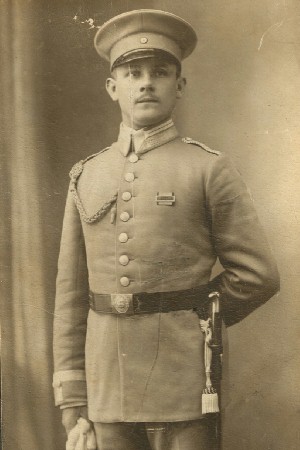
Unteroffizier
of the
South West African Schutztruppe
At his left side is a kS98 bayonet with a bayonet knot in
imperial colours for NCOs.
Photo ©
Joe Robinson |
|
| |
|
|
|
|
| |
|
|
|
S98aAS Bayonet
from the South West
African Schutztruppe
Photos ©
Roy Williams, author of
Collectors Book of German Bayonets |
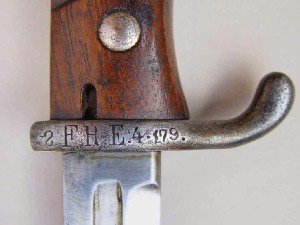 |
 |
|
The S98 bayonet was issued
to the Schutztruppe reinforcements sent to South West Africa
at the outbreak of the Herero Rebellion in 1904. They
were usually marked with their regiment marking rather
than simply "KS" later seen on Schutztruppe
kS98 bayonets (only one S98aA has been seen in a private
collection with "KS" markings). The
markings "2.F.R.E.4.179." on the hilt
of this bayonet show it to have been issued to the
2.Feld-Regiment, 4. Ersatz-Kompagnie of the
Schutztruppe of South
West Africa, weapon number 179. The Schutztruppe were only
temporarily formed into regimental units during the Herero
Rebellion. This
bayonet was made
at Erfurt in 1900 (marked "W00") and has a sawback
blade. Like all S98aA bayonets it has a one piece wooden
grip and a leather scabbard.
S98aAS Bayonet
from the South West
African Schutztruppe
Photos ©
Chris Boonzaier of the
Soldier's Burden Website |
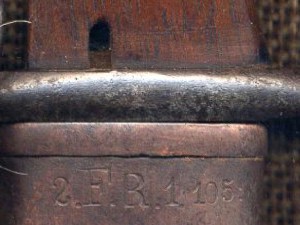 |
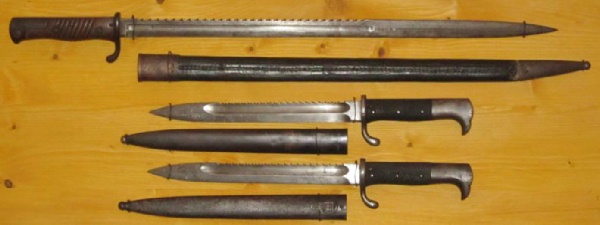 |
| The markings
"2.F.R.1.105" on the scabbard show that it (and presumably its
matching bayonet) were issued to the
2.Feld-Regiment, 1. Kompagnie of the
Schutztruppe of South
West Africa, weapon number 105. As mentioned above
the
Schutztruppe were only temporarily formed into regimental units
during the Herero Rebellion. This
bayonet was made
at Erfurt in 1899 (marked "W99") and has a sawback
blade. Like all S98aA bayonets it has a one piece wooden
grip and a leather scabbard.
Note the length of
the S98 bayonet when compared to the two shorter kS98 bayonets in
the photograph above right.
| S71/84
Bayonet possibly from the South West African Schutztruppe
Photos by C Dale,
Swakopmund, Namibia |
 |
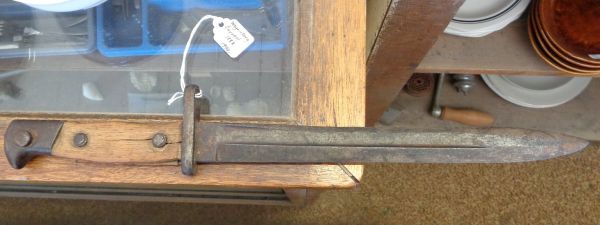 |
| The feint
markings “5.FP 2.123” on the hilt could be attributed to 5.
Fuhrpark-Kolonne
of the Schutztruppe of South West Africa.
As mentioned above
the
Schutztruppe were only temporarily formed into regimental units
during the Herero Rebellion. This
bayonet was made
by
Weyersburg
in 1888 (marked "W88") and has a one piece wooden
grip. This bayonet was seen for sale in a second hand
shop called Bargain Corner in Swakopmund, Namibia. The shop
keeper kindly let me photograph it for this website. |
|
| |
|
kS98
Bayonet with Leather Grips from the South West African
Schutztruppe
Photos ©
Chris Wood |
 |
 |
The markings "KS4892" on the
hilt and scabbard show this bayonet to
have been issued to the Kaiserliche Schutztruppe (of German South
West Africa), weapon number 4892. This bayonet was made at Erfurt in 1912 (marked "W12")
and has the original leather grips held with three rivets and a steel scabbard. Like all kS98
bayonets it has a sawback blade. The Erfurt kS98 with leather grips
was the most commonly issued variant to the South West African
Schutztruppe (see
more examples below)
| kS98 Bayonet
with Wooden Grips from the South West
African
Schutztruppe
Photos ©
Chris Boonzaier |
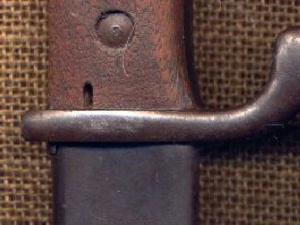 |
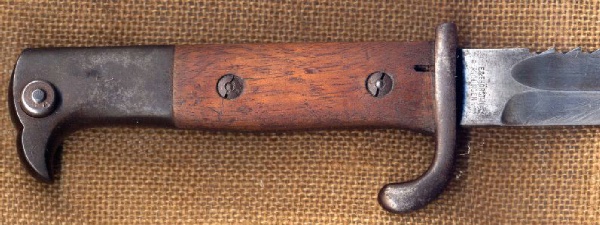 |
| This bayonet has
no unit markings. It was made by E&F Hörster (note the
maker's mark just visible on the blade in the photo on the
right) in 1913 (marked "W13") with wooden grips. As
previously noted on this website the E&F Hörster 1913 wooden
gripped kS98 bayonets all seem to be from one batch made for
colonial issue. It also has the marking Erfurt on the other
side of the blade. This bayonet was captured by Private ER
Cumming of the 1st South African Infantry (Durban Light
Infantry) and taken home to Natal by him after the campaign
of 1914-15. The
Imperial War Museum in London also has an E&F Hörster wooden gripped kS98
bayonet with a handwritten tag saying it was captured in
German South West Africa 1915. Interestingly no unit
markings can be seen on that bayonet either, although it may
be that the bayonet is displayed with them facing the wall
rather than the visitor. |
|
| |
|
kS98 Bayonet
with Composition Grips from the South West
African
Schutztruppe
Photos ©
Roy Williams |
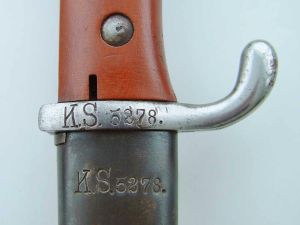 |
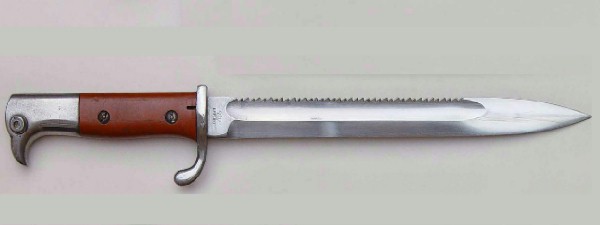 |
|
The
markings "K.S.5278" on the hilt and scabbard show this bayonet to have been issued to the
Kaiserliche Schutztruppe (of
South West Africa), weapon number 5278.
The blade was made at Erfurt in 1912
(marked "W12"). It has been re-gripped with composition
grips made of unvulcanised rubber first introduced
in 1914. |
|
|
|
|
S71/84
Dress Bayonet from a Veteran of the South West African
Schutztruppe
Photos ©
Roy Williams |
|
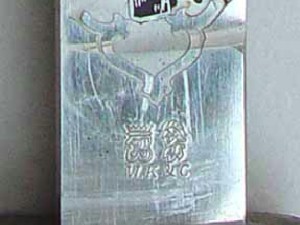 |
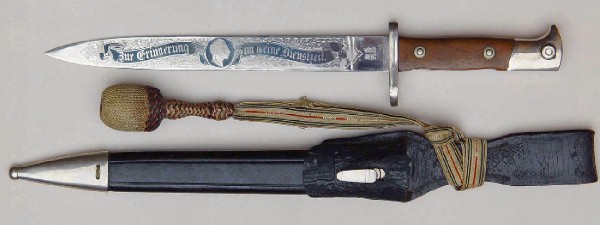 |
|
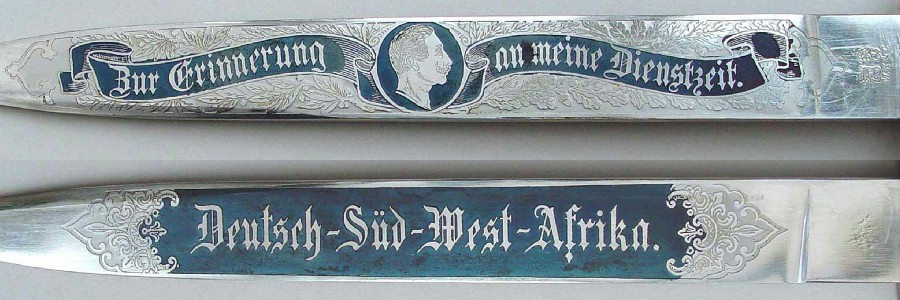 |
This is a privately purchased S71/84 bayonet with a beautifully
engraved blade made for a veteran of the South West African
Schutztruppe. It has no unit or date markings but has maker's
mark in the form of a king and a knight over "WK&C" for
Weyersberg, Kirschbaum and Company on the top of the blade on one side.
The engravings are in cornflower blue for South West Africa and
read "Zur Erinnerung an meine Dienstzeit"- (In memory of my
service) with the Kaiser's head on one side and "Deutsch-Süd-West-Afrika"
on the other. The scabbard is of black leather
with nickel plated mounts and has a black patent leather frog.
The knot is an officers sword knot ("Portepee") in the
imperial colours, showing the original owner to be an officer or
senior NCO (see Bayonet and Sword
Knots). |
|
|
|
|
More kS98
Bayonets with Leather Grips from the South West African
Schutztruppe
As can be deduced by the number of
these bayonets that appear in modern collections, the Erfurt kS98
with leather grips was the most commonly issued South West African
Schutztruppe bayonet. Many of these examples were captured by South
African troops in 1914/15 and taken home as souvenirs. Their weapon
numbers and dates of manufacture are noted below (eg. W06=1906).
Non-matching bayonet and scabbard combinations are quite common and
while some may have been put together by post-war collectors many
may also have been in use by the Schutztruppe when one or other was
damaged or lost. All these blades are marked as having been made at
Erfurt. |
|

K.S.1613 W06
Photo © Francois Kruger |
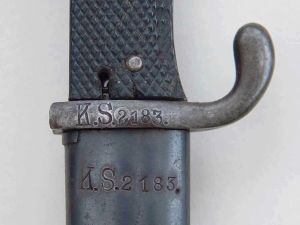
K.S. 2183. W12
Photo ©
Roy Williams |

K.S.1516 W10
Photo ©
Chris Boonzaier |
| |
|
|
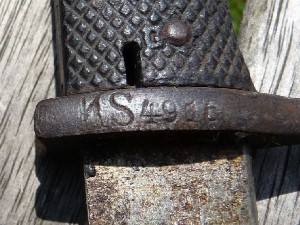
KS4916
W12
Photo © Keith Homer |
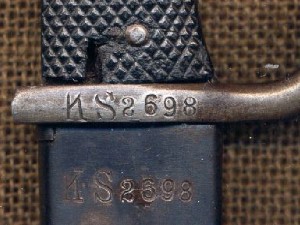
KS2698 W12
Photo ©
Chris Boonzaier |

K.S.11067
Photo © Nate
Friedlander |
| |
|
|
|
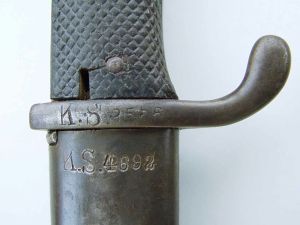
K.S. 2556 W12
Photo ©
Roy Williams
Note- The scabbard has the
markings K.S. 4692 showing it originally to have been issued with
bayonet number 4692. |
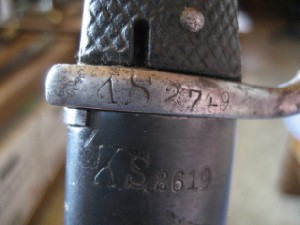
K.S. 2749 W12
Photo © Dow Cross
Note- The scabbard has the markings K.S. 2619. |
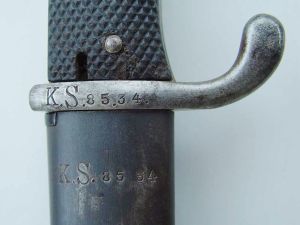
K.S.85.34 W06
Photo ©
Roy Williams
Note- the punctuation between the
numbers 85 and 34 on the hilt is not present on the scabbard and
seems to be incidental. |
| |
|
|
| |
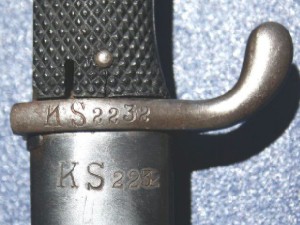
KS 2232
Photo ©
Chris Boonzaier
Note- This kS98 bayonet is STOLEN PROPERTY. It
went missing in the post between South Africa and Germany in 2011.
If you know its whereabouts please contact the webmaster here.
|
|
| |
|
|